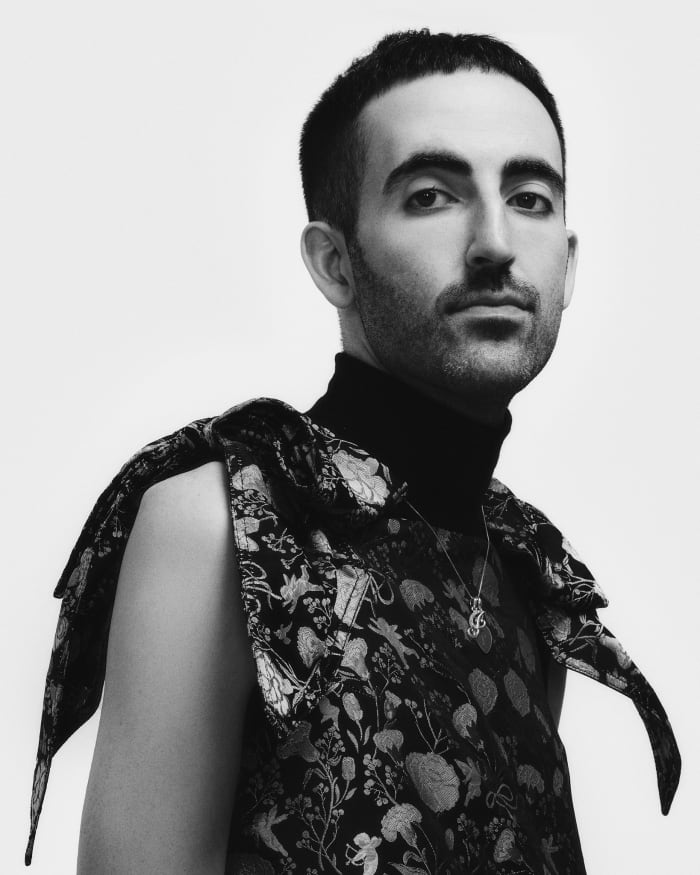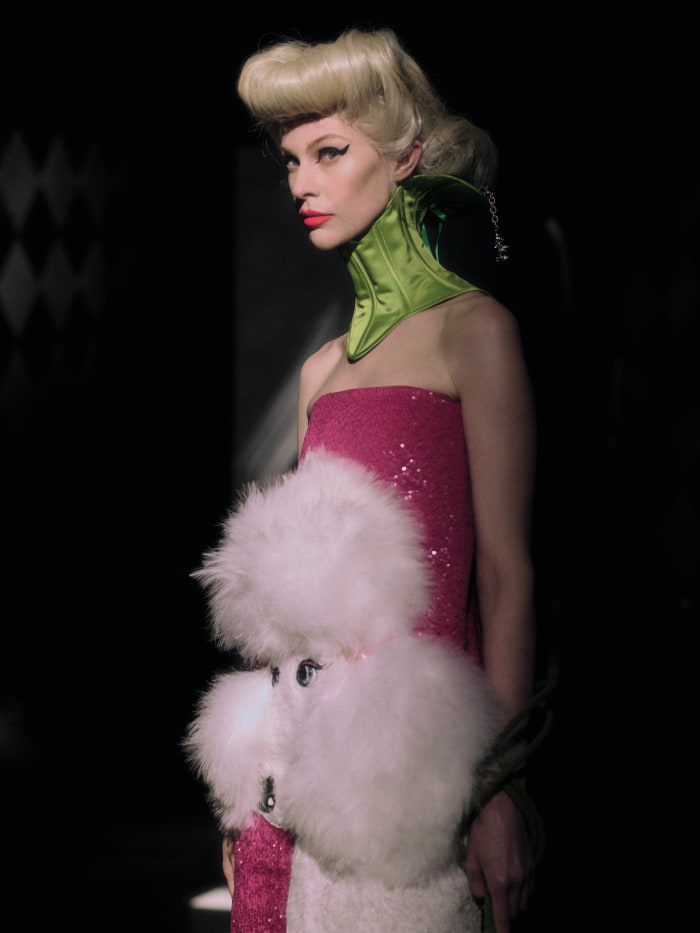Jackson Wiederhoeft’s designs are not for the faint of heart. They’re not entirely comfortable, not easily digestible. What they are, though, is exciting.
Since Wiederhoeft, the person, debuted Wiederhoeft, the demi-couture line, in New York City three years ago, he’s grown a circle of admirers charmed by this exuberant celebration of craft. His 16-look Resort 2023 collection, for instance, opens with a candy-pink column dress, embellished with sequins and a feather-embroidered poodle. Later, a sleeveless gimp suit — dotted with crystals, of course — sits beneath a white satin suit.
For today’s fashion houses, it’s not uncommon to invest in couture for the prestige alone, a bottle of Bollinger that elevates any table. But for Wiederhoeft, couture is as much a treat as it is the full meal — nay, feast. And what’s a dinner party if not for a dazzling presentation?
Now a finalist in this year’s CFDA/Vogue Fashion Fund, Wiederhoeft cut his teeth at Thom Browne, where he spent five years managing the design and sampling of the brand’s hand embroidery. Though he’s known to show the odd suit, Wiederhoeft has taken his namesake aesthetic in a more classically romantic, albeit still subversive direction. (Think more Marie Antoinette than Inspector Javert.) But like his previous employer, Wiederhoeft dabbles in the performative. After all, this sense of theatrics is what brought him to Thom Browne in the first place.
In 2013, while pursuing his BFA at the Parsons School of Design (where he won “Women’s Designer of the Year” in 2016), Wiederhoeft interned with Browne when he was designing the costumes for an off-Broadway production called “Queen of the Night.”
“The suiting never really spoke to me in the sense that I’m not a big tailoring person,” Wiederhoeft says, “but the theatricality and the drama and the dedication to the narrative was always very exciting.”
It wasn’t an altogether typical entrance to the fashion world. Where some aspiring designers spend their earliest years trafficking samples and creating trend boards, Wiederhoeft spent his watching the curtain rise and fall, answering not only to Browne, but to directors, producers and even actors. What’s more, he didn’t have to sell clothes in the end, which was liberating in its own way. But as Wiederhoeft explains, costume design comes with its own particular set of hurdles separate from those associated with commerce.
“There are different limitations, especially in regard to how you can construct the clothes and the kind of fabrics you can use,” he says. “You have a lot of considerations for mobility and washability that you definitely don’t have with a runway show.”
Yet for Wiederhoeft, the experience was invaluable. Even the most grandiose of his demi-couture looks possess an inherent level of wearability, be it in the cut of the corsetry or the flare of the princess skirt. This also means that among the cupcake gowns and feather-fringe hems are a selection of “casual” pieces — oversized hoodies in silk faille here, corduroy puffer jackets there — that bring the romance of it all back down to earth. It’s a balance Thom Browne too masters, using mind-numbingly meticulous detail to amplify each and every garment.
Scroll to Continue
Working in the design development department, Wiederhoeft had his hands on all 12 collections, collaborating with every other division, from accessories to footwear, to breathe life into Browne’s vision. Say Wiederhoeft created an anchor accoutrement that Browne himself felt represented the energy of the season — it was Wiederhoeft’s job, then, to help incorporate said “embroidery” (he prefers the term “fabric manipulations”) throughout the range, whether on purses or atop cardigans. But this being Thom Browne, it always came back to the suits.
“The tailoring was very rigid, but there was so much freedom within the textiles,” he says. “There’s always the classic suit you have in every collection, but it was really down to the embroideries and surface design, combined with the show, that made things different from season to season.”
To work at Thom Browne is to be entirely submerged in the Thom Browne universe. It is, as Wiederhoeft says, both a mindset and a practice, and however valuable it was, it didn’t always leave much room for independent creativity — or for Wiederhoeft to plot an adventure of his own.
“I had been sketching my first collection at my desk on Post-it Notes the whole time I worked for Thom,” he says. “It was all in. I was very invested, obviously, and that was great. But after I left, I was kind of like, ‘Okay, I have to do this collection. We’ll see what happens.’ I’s been seven collections since then.”
Two of those seven have been dedicated to bridal, which, today, comprises 95% of his business. The Wiederhoeft bride, he says, is “an old-fashioned girl with an old-fashioned mind, but always iconoclastic in her own way.” For the Spring 2022 bridal offering, crisp pearly silks come alive in the particulars, like crystal bows, floral jacquards and beaded filigree artwork. His pièce de résistance is none other than the eponymous Jackson Dress, featuring a boned corset with laced back, oversized sleeves and crystal-edged flounces, and shown with a sculpted tiara shaped with crystals strung onto wire. To put it on is to, well, commit, as much to one’s partner (in sickness and in health, etc.) as to the performance of actually wearing it.
“When we tend to think about an early starting designer who’s coming out of New York, there’s often either this extreme underground sensibility, or there’s an extreme sportswear, ‘I’m-dying-to-get-into-Bergdorf’ sensibility — that real uptown polish,” says Rachel Tashjian, fashion news director at Harper’s Bazaar. “And what’s interesting about Wiederhoeft is there’s this feeling of it coming from an atelier sensibility. It looks very well made, even though they’re really crazy clothes.”
Of the lessons he gleaned at Thom Browne — of all the years spent pouring over beadwork and devising various trompe l’oeil — Wiederhoeft often finds himself going back to one, something he never had to consider in his years in the theater.
“You have to be smart about what you offer commercially,” he says. “If you don’t feel like it represents the brand, don’t sell it. We did meetings where Thom would be like, ‘Oh, we’re going to sell too many of that. We have to cancel it. It’s too easy. It doesn’t challenge the wearer enough.’ That’s really strong, to forsake sales in favor of something that has integrity. That’s something I try to hold onto, making sure every garment tells some aspect of the story I’m trying to say.”
Wiederhoeft remembers popping into the Barneys and coming across the singular Thom Browne rack in the middle of the men’s floor. There was power in that, he says.
“It’s either for you or it’s not, and I think that’s perfect. It’s great that the focus is on the audience and not trying to please everyone.”
Never miss the latest fashion industry news. Sign up for the Fashionista daily newsletter.


